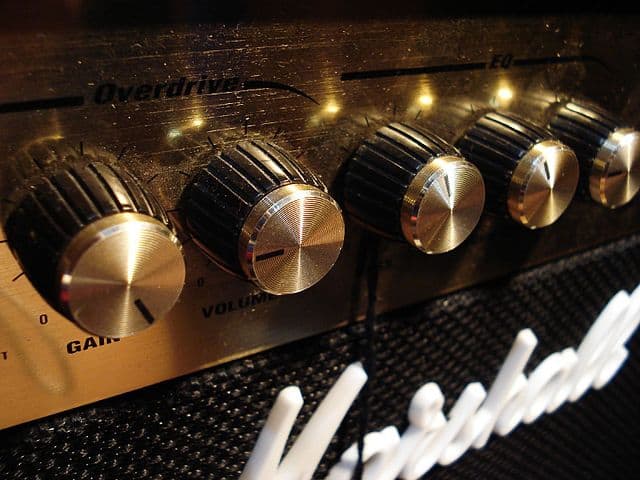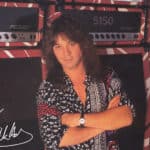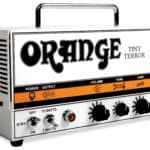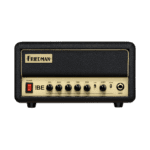Marshall amps are one of the most iconic images of rock and roll. So it is to the company’s advantage to maintain the well-known look of their amps.
But that means that a lot of them tend to look the same from a distance.
So let’s get into what some of the differences are between some of the popular JCM series amps.
The JCM designation on the front of Marshalls can mean a lot of things. Usually, a higher series number means more channels and gain stages. But there have been other improvements over the years such as reverb and effects loops.
JCM### is the name of the series and stands for the founder of the company James Charles Marshall.
This moniker loosely defines the basic features and circuit of the amps but within the different series, there are various models with 25 to 100 watts of power, single/multiple channels, and combo/head design.
So don’t get too caught up in the “JCM” hype and pay careful attention to what each particular amp offers.
Marshall JCM800’s main features
Marshall Amplification had been around for almost twenty years by the time they released the JCM800 series in 1981. The JCM series was (usually) a continuation of Marshall’s previous amplifiers that used a master volume control.
Now most people categorize the JCM800 series as one-channel amps since the very popular 2203 (100 watts) and 2204 (50 watts) models only have one channel.
But things get messy quickly and there are models in the JCM800 line with two channels as well: the 2205 (50 watts) and 2210 (100 watts).
These two amps also feature reverb whereas the 2203 and 2204 do not. And there are even some rarer JCM800 amps without a master volume control.
So for the sake of keeping things somewhat simple and preserving our sanity, let’s focus on the famous 2203 and 2204 models.
These amps use ECC83 (12AX7) preamp tubes and EL34/6550 power tubes. And the master volume allowed you to run the preamp gain hot to get tube saturation while using the master volume to keep things from getting too loud.
But 2203s and 2204s only have one channel so if you want to vary your tone in a song you will have to rely on pedals or your guitar’s controls.
They are simple but legendary amps that are worth checking out.
Here is some footage of a Gibson Les Paul being played through a 2203 model from 1988:
Marshall JCM900’s main features
So with the single-channel amps dominating the JCM800 series, in the 1990s Marshall changed the series name to JCM900 and followed the aforementioned 2205 and 2210 models.
The new standard (compared to the 2203 and 2204 models) was to have two channels with a foot switch option, an effects loop, more (solid-state) distortion on the second channel, and reverb with separate controls for each channel.
The heavy hitters of the JCM900 series were also available in 50 watts (4500 model) and 100 watts (4100 model). Other differences were that the power tubes were sometimes switched to 5881 (6L6) tubes (supply problems?) and the second input jack was removed.
The B channel was considered the lead channel with the preamp gain sometimes labeled from 0-20 versus 0-10 on channel A.
So there were a lot more options to get different sounds with this series but not everyone loved the diode clipping method that was used to raise the gain.
Here is a link to a video with a PRS SE being played through a 4100 model from 1996:
Marshall JCM2000 main features
Perhaps because the JCM900 series wasn’t as well-received as they hoped it would be, by 1997 Marshall re-branded with the JCM2000 lineup.
These amps were mostly a continuation of the JCM900 models with some additions such as two selectable gain stages for each channel.
These amps were sold as DSL### (Dual Super Lead (wattage power)). Later they also offered JCM2000 TSL###s (Triple Super Lead (wattage power)) with three channels and some of the amps had switched to digital reverb instead of spring reverb.
By this time the amps offered a lot of gain and options but they had become pretty complicated. I mean, the control panels on some of those later amps look like small mixing boards.
Did Marshall go too far? Take a listen to a Triple Super Lead here:
Main differences between Marshall JCM800, 900, and 2000 amps
So from the simplicity of the single-channel amps in the JCM800 series to the dual-channel models that evolved into JCM900s and JCM2000s, there are a lot of models to compare.
I actually think that Marshall has overused the name of these JCM series to the point that they have really muddied the waters.
Concerning the amps in these series that I have focused on, I guess they all use EL34 or 6L6 tubes for their power, offer at least a 3-band EQ, and a master volume.
Marshall has certainly influenced music but they also follow musical trends. So as far as the series numbers go, I think it is safe to associate JCM800s with styles of rock music from the 1960s to 1980s, JCM900s with rock in the 1990s, and rounding up from 1997 to 2000, JCM2000s would represent the music of the new millennium.
And the higher the series number, the more options, and available gain stages/channels there will likely be.
But you really have to decide based on the model number because that is what matters here. I believe the JCM2000 series is currently discontinued but JCM800 and JCM900 amps are available as tweaked re-issues of the 100-watt versions.
For example, the current JCM800 2203X comes with a series effects loop, which the originals did not have.
Which one should you get?
So if you decide you need some Marshall tone in your life there are tons of options. I have just tried to focus on the defining amps of each series because there is a lot of crossover.
Anyway, if you are a tube-tone purist then you will probably be best off with a 2203 or 2204 model from the original JCM800 series because the later series added more solid-state and digital technology for gain, reverb, etc.
Or if you prefer to get your gain from pedals these are also great choices. The 50-watt 2204 is what I would probably select if I was in search of a vintage Marshall powerhouse.
But if you need more than one channel, or want all of your tone in one tidy package, the JCM900 or JCM2000 amps have their purpose too, especially if you play in a punk or metal band.
Or… you could just sit and wait patiently for Marshall to release the JCM3000 series.

Hello there, my name is Ramiro and I’ve been playing guitar for almost 20 years. I’m obsessed with everything gear-related and I thought it might be worth sharing it. From guitars, pedals, amps, and synths to studio gear and production tips, I hope you find what I post here useful, and I’ll try my best to keep it entertaining also.





